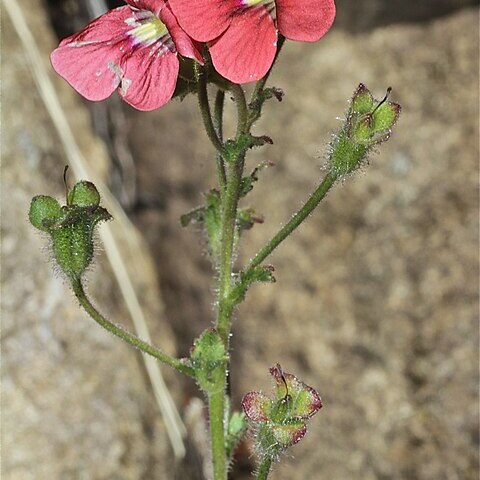Perennial herb developing a stout caudex up to c. 10 mm diam. at the crown, stems c. 150-600 mm long, simple to laxly branched, sprawling, glandular-villous, hairs up to 1-3 mm long, leafy. Leaves opposite or becoming alternate upwards, pseudofasciculate, largest blades 10-35 x 8-35 mm, ovate to subrotund tapering to a petiolar part 3-10 mm long (roughly 1/2-1/5 length of blade), obtuse, margins crenate, the longest lobes occasionally with a tooth, both surfaces glandular-villous, hairs up to 1-3 mm long (longest hairs on petiolar part), glistening glands also present particularly on lower surface. Flowers solitary in the leaf axils forming long leafy racemes. Pedicels up to 9-35 mm long. Calyx tube 0.2-0.8 mm long, lobes c. 3.8-5.5 x 1-3 mm, spathulate, glandular-villous, hairs up to 0.5-2 mm long, glistening glands as well. Corolla tube 3.5-6 x 2-4 mm, abruptly expanded into the limb, mouth dorsoventrally compressed, limb oblique, c. 7-20 mm across lateral lobes, posticous lobes 3-7 x 3-7 mm, anticous lip porrect, anticous lobe 2-8 x 2.5-8.5 mm, all lobes suborbicular, glandular-pubescent outside, hairs up to c. 0.5-1 mm long, glistening glands as well, broad transverse band of clavate hairs in throat extending briefly onto base of lower lip, lobes dark red to terracotta or rose-pink, rarely dark lilac, main veins dark, palate bright yellow. Stamens: posticous filaments 1.5-2.5 mm long, glandular-puberulous above, minute sessile glands at base, anthers 0.8-1.4 mm long, anticous filaments 0.5 mm-1 mm long, glandular-puberulous, anthers 0.6-5 mm long. Stigma 0.3-0.5 mm long, included. Style 2.2-3 mm long. Ovary 1-1.5 x 0.8-1.2 mm. Capsules c. 4-6 x 2.5-3 mm, glistening glands all over, a few minute hairs at apex. Seeds c. 0.3-0.6 x 0.3-0.4 mm.
More
Sprawling, perennial herb, stems up to 600 mm long, laxly branched if at all, glandular-villous, leafy. Leaves pseudofasciculate, ovate to subrotund, petiolate, obtuse, crenate, bigger lobes sometimes with a tooth, glandular-villous on both surfaces, plus glistening glands especially on lower one. Flowers large, single, axillary, forming long, leafy racemes. Calyx: tube up to 0.8 mm long; lobes spathulate. Corolla: tube up to 6 mm long, opening quickly into limb; limb oblique; lobes ± round, dark red to terracotta or rose-pink, rarely dark lilac, veins dark, palate yellow.

